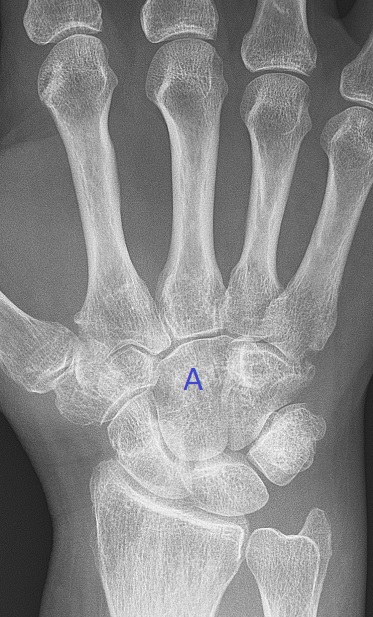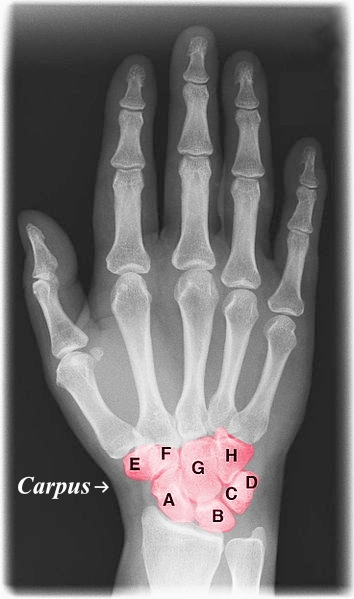
Trauma

A 32 year old pianist presents to the Emergency Department complaining of pain in the right wrist following a fall. An x-ray is performed, what structure is labelled 'A'?
Answer:
This is the capitate.Scaphoid Fracture and Other Carpal Injuries
Trauma
Last Updated: 21st July 2022
Clinical anatomy

Carpal Bones. (Image by Dr. Jochen Lengerke at de.wikipedia. Painted color by User:Was a bee. (File:Xray hand.jpg) [Public domain], via Wikimedia Commons)
- Proximal row
- A: Scaphoid
- B: Lunate
- C: Triquetrum
- D: Pisiform
- Distal row:
- E: Trapezium
- F: Trapezoid
- G: Capitate
- H: Hamate
Anatomical snuffbox borders:
- Ulnar border – tendon of the extensor pollicis longus
- Radial border – tendon of the abductor pollicis longus and extensor pollicis brevis
- Proximal border – styloid process of the radius
- Distal border – base of thumb metacarpal
- Floor – carpal bones; scaphoid and trapezium
- Roof – skin
Anatomical snuffbox contents:
- Radial artery
- Branch of the radial nerve
- Cephalic vein
Scaphoid fracture
Spanning the two rows of carpal bones, the scaphoid is at particular risk of injury. Scaphoid fractures typically occur from falling onto an outstretched hand or from ‘kick-back’ injuries e.g. football goalkeeper making a save. The combination of fractures being difficult to identify on X- ray and the risk of significant complications demands a careful approach. The scaphoid mostly fractures through the waist, but sometimes through the tubercle (the latter does not give rise to significant complications).
Clinical features
Assess and document whether there is evidence of scaphoid fracture in anyone who presents with a wrist injury. Pain and swelling over the radial aspect of the wrist may be accompanied by difficulty gripping.
Examine for:
- Tenderness over anatomical snuffbox
- Tenderness over palmar aspect of scaphoid tubercle
- Scaphoid pain on compressing the thumb longitudinally (telescoping)
- Scaphoid pain on gentle flexion and ulnar deviation of the wrist
X-ray
- Fractures of the scaphoid may be difficult to see (or not be apparent at all) on initial X- rays.
- Request specialised scaphoid (not wrist) views if there is clinical suspicion of scaphoid fracture.
- Four views are usually taken (AP, lateral, right, and left obliques).
Management
- Treatment where fracture is visible
- If there is a visible fracture on X- ray, immobilise in a cast and arrange follow- up in the hand/ fracture clinic. Although it is traditional to apply a scaphoid- type POP, evidence suggests that it is equally acceptable to use a Colles- style POP.
- Clinically suspected scaphoid fracture
- If there is clinical suspicion of a scaphoid fracture, but the X- rays look normal, apply a splint and arrange review (usually in 10– 14 days). Most of these patients will turn out not to have a fracture, but failing to adequately immobilise those patients who do have a fracture may increase the risk of complications.
- Aim to discharge patients if there is no clinical evidence of fracture at review at 10– 14 days after injury. If, however, there is continuing pain and/ or scaphoid tenderness, arrange further imaging. The choice includes repeat X- rays, MRI, and CT. Of these, MRI has the advantage of avoiding ionising radiation and the potential to pick up other injuries not seen on X- ray.
Complications
- Non-union
- Delayed union
- Malunion
- Avascular necrosis
- Secondary osteoarthritis
Lunate and perilunate dislocations
- Definition:
- Perilunate Dislocation = Lunate stays in place, capitate is displaced
- Lunate Dislocation = Capitate stays in place, lunate is displaced
- Background:
- Typically occur via high-energy FOOSH injury (fall from height, RTC)
- Commonly missed (~25%) on initial presentation
- Must rule-out median nerve injury
- Must rule out carpal bone fractures
- Clinical features:
- Perilunate dislocation: dorsal swelling with palpable mass
- Lunate dislocation: volar swelling with palpable mass
- X-ray:
- Perilunate dislocation:
- Lateral view: Capitate is displaced dorsal to lunate and lunate retains its normal contact with radius
- PA view: Capitolunate joint space is obliterated as the bones overlap one another
- Lunate dislocation:
- Lateral view: Lunate is pushed off the radius into the palm ("spilled teacup" sign)
- PA view: Lunate has triangular shape ("piece-of-pie sign")
- Perilunate dislocation:
- Management:
- Closed reduction and long-arm splint
- Requires emergent ortho consultation (very difficult to reduce with high incidence of median nerve compression), and usually emergent operative management

Other carpal injuries
- Fractured hook of the hamate
- Local palmar tenderness may give rise to suspicion of a fracture of the hook of the hamate.
- Diagnosis can be difficult— specialised X- rays or CT may be required to demonstrate the fracture.
- Immobilise in POP and refer to the fracture clinic.
- Flake avulsion carpal fractures
- Small avulsions from the dorsum of the carpus are often from the triquetrum.
- Treat with immobilisation in a POP backslab or a wrist support splint and analgesia, and refer to the fracture clinic.
Report A Problem
Is there something wrong with this question? Let us know and we’ll fix it as soon as possible.
Loading Form...
- Biochemistry
- Blood Gases
- Haematology
| Biochemistry | Normal Value |
|---|---|
| Sodium | 135 – 145 mmol/l |
| Potassium | 3.0 – 4.5 mmol/l |
| Urea | 2.5 – 7.5 mmol/l |
| Glucose | 3.5 – 5.0 mmol/l |
| Creatinine | 35 – 135 μmol/l |
| Alanine Aminotransferase (ALT) | 5 – 35 U/l |
| Gamma-glutamyl Transferase (GGT) | < 65 U/l |
| Alkaline Phosphatase (ALP) | 30 – 135 U/l |
| Aspartate Aminotransferase (AST) | < 40 U/l |
| Total Protein | 60 – 80 g/l |
| Albumin | 35 – 50 g/l |
| Globulin | 2.4 – 3.5 g/dl |
| Amylase | < 70 U/l |
| Total Bilirubin | 3 – 17 μmol/l |
| Calcium | 2.1 – 2.5 mmol/l |
| Chloride | 95 – 105 mmol/l |
| Phosphate | 0.8 – 1.4 mmol/l |
| Haematology | Normal Value |
|---|---|
| Haemoglobin | 11.5 – 16.6 g/dl |
| White Blood Cells | 4.0 – 11.0 x 109/l |
| Platelets | 150 – 450 x 109/l |
| MCV | 80 – 96 fl |
| MCHC | 32 – 36 g/dl |
| Neutrophils | 2.0 – 7.5 x 109/l |
| Lymphocytes | 1.5 – 4.0 x 109/l |
| Monocytes | 0.3 – 1.0 x 109/l |
| Eosinophils | 0.1 – 0.5 x 109/l |
| Basophils | < 0.2 x 109/l |
| Reticulocytes | < 2% |
| Haematocrit | 0.35 – 0.49 |
| Red Cell Distribution Width | 11 – 15% |
| Blood Gases | Normal Value |
|---|---|
| pH | 7.35 – 7.45 |
| pO2 | 11 – 14 kPa |
| pCO2 | 4.5 – 6.0 kPa |
| Base Excess | -2 – +2 mmol/l |
| Bicarbonate | 24 – 30 mmol/l |
| Lactate | < 2 mmol/l |

